Every year, during “RSV season” which is typically from the end of October until about the end of January, I usually catch some posts on social media about babies that have RSV and moms asking what to do. Just this week, in a Nashville Facebook group, I saw at least 7 or 8 posts from different moms all with babies diagnosed with RSV and I could sense their anxiety and remember my own. My daughter had RSV when she was 5 months old. It started with a typical visit to our pediatrician and escalated to a 5-day stay at a hospital. Thankfully, she recovered fully, but at the time, I was incredibly stressed out, tired, and upset.
So here is the lowdown on RSV from both a clinical side and my personal scoop:
What is RSV?
Respiratory Syncytial Virus is a contagious airborne virus (transmitted by coughing or sneezing into the air). By the age of 2, most kids have had RSV, and for the most part, most kids recover just fine within 10-14 days.
How is it diagnosed?
It can be diagnosed by exam and/or through a nasal cotton swab lab test.
What are the symptoms?
It can be tricky deciphering it from the common cold. Symptoms may include:
- Coughing
- Stuffy/Runny Nose
- Sore Throat
- Fever
So, is it JUST a cold?
Not exactly. For most, RSV isn’t a very big deal. But we have to watch our babies, in particular, under 6 months old, as they can have more difficulty handling the symptoms. Additionally, younger children who were born premature, have underlying medical conditions, or heart or lung conditions, are more at risk for complications related to RSV.
What should I watch out for with my baby and when should I be concerned?
If you start noticing any of these symptoms, you should contact your pediatrician:
- Poor feeding, disinterest in the bottle/breastfeeding. If your baby seems uncomfortable/fussy while feeding, it is probably because it is difficult to get enough air in through the nose while sucking, making feeding really tough.
- Severe coughing (can induce vomiting).
- Blue-tinted skin around the mouth (especially when attempting to feed).
- Sleepiness
- Lethargy, your baby just seems ‘out of it’ and not interested in anything.
- Decrease in wet diapers, no tears when crying (indicating dehydration).
What are the complications?
It is not unusual for babies to have earaches or ear infections along with RSV, but a more serious complication is bronchiolitis (an inflammation of their little air passages). This causes rapid shallow breathing and wheezing and likely will trigger a hospital stay.
What can I do at home/What is the treatment/What are your tips?
Treatment involves a lot of comfort care and support:
- If not feeding well, it is very important to make sure your baby is staying well hydrated. Check to make sure baby still has wet diapers and tears when crying.
- Offer more frequent but shorter feeding sessions with a bottle/breastfeeding. Baby will have to work harder to suck and will become exhausted, so allowing feedings more frequently but for shorter amounts of time will help maintain hydration.
- Allowing the baby to rest on you, skin-to-skin, and in an upright position may help ease some difficulty breathing due to drainage and cough.
What if my baby is hospitalized?
If your baby requires hospitalization, it will likely be for intravenous fluids (IV) and for humidified oxygen support (usually in a tent). Sometimes, a breathing treatment may be necessary by nebulizer (a mist containing medicine is sprayed into the air near baby to help open up those tiny airways). Especially if you are a new mom, even the thought of your baby being hospitalized is so scary. Take comfort in knowing the hospital is the best place to help lead towards recovering sooner by providing any necessary treatment if your baby is struggling at home.
My daughter was born at 37 weeks and had no other medical conditions, but RSV really knocked us for a loop. The first 3 days she had the virus, she seemed to be managing fine, but around the 4th or 5th day, her periods of wake became fewer and she just became increasingly spaced out. She looked very sick, as you can see in the pictures. She was disinterested in everything when she was awake, including any feedings. Her cough fits were extreme and she was wheezing. For all these reasons, the best decision was to admit her to the hospital to help support her through the virus. Although it is terrifying to see your little baby hooked up to an IV, I felt relief knowing she was going to receive adequate hydration. She was able to rest more comfortably in the tent with humidified air, and received RT (respiratory therapy). She showed gradual improvement over the next 4 or 5 days and was then strong enough to go home. A heads-up to breastfeeding moms. Because her feedings were so poor, I wanted to make sure I kept up my supply by pumping. The hospital offered a breast pump and lactation nurse support. I ended up accumulating a great supply to freeze.
How can I prevent this from happening?!
The reality is, like most things in motherhood, there is only so much we can do. RSV is a very contagious virus that most kids will get, but here are a few good tips to practice in general:
- Wash hands often
- Limit contact with people who are just getting over a cold or virus (especially if your baby was born premature)
- No smoking!
- Wash toys and counters often
Useful Products To Have When A Child Has RSV Or Other Respiratory Viruses (always check with your pediatrician/healthcare provider for their recommendations):
- Crane Ultrasonic Cool Mist Humidifier
- Boogie Wipes
- FridaBaby Nasal Aspirator
- Little Remedies Little Noses Saline Drops
- Infant Optics DXR-8 Video Baby Monitor With Interchangeable Optical Lens
•Linda Scruggs is a nurse, digital health enthusiast, blogger, and mother of 2 young children. She founded MOMtility, a fertility support site that steps beyond the walls of a traditional medical practice to offer patient empowerment and education. As a nurse, Scruggs believes not only in keeping patient experience at the forefront, but that telemedicine and social media can serve as the platform to transform healthcare delivery into a boundless, patient-centered system.
This post contains amazon affiliate links.

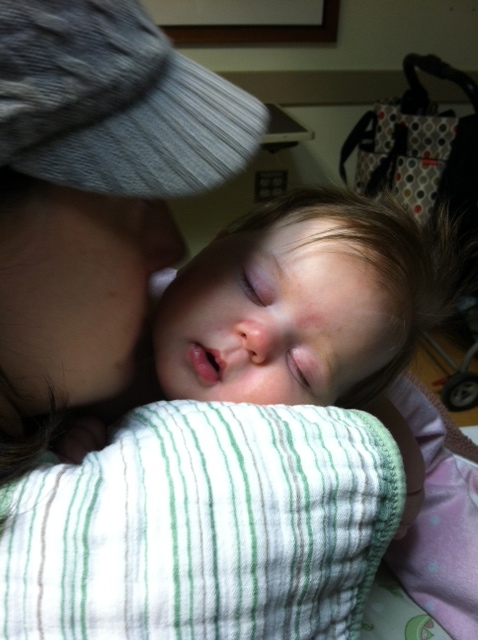
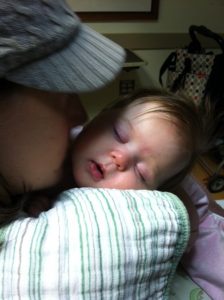
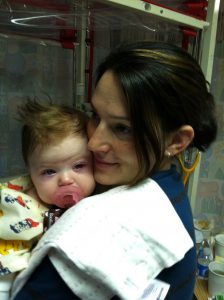
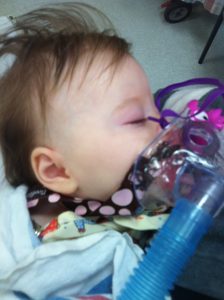
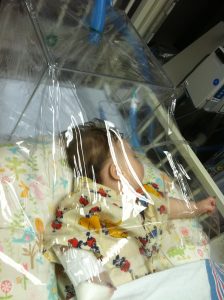
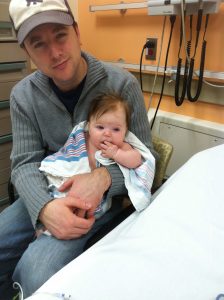





Wonderful article. My son was 5 months old and we had no idea what was wrong, the blue tint caused us to rush him to the hospital. He spent 5 days in ICU. I encourage mothers and fathers to read this article.
Delie, I hope your son fully recovered. Thank you for the kind comment!
I hope everyone that reads your article appreciates the valuable discussion presented here. Most parents and family members have never heard of RSV until it’s affected their children. Worthy to note; many other viruses may also cause the bronchiolitis symptoms and will be treated the same way: comfort, hydration, nasal suction when necessary (avoid using saline drops), oxygen support when needed. I must stipulate a strong disagreement in your post. The use of humidified oxygen tents should not be used. Neither should “cool mist blow-by” and certainly NEVER use bedside humidifiers/vaporizers at home. Up to date pediatric facilities have long gave way the practice of tents and un-medicated mist realizing from evidence based research that these methods prove no benefits and often make symptoms worse. This therapy is categorized as Bland Aerosol Delvery and judged as contraindicated by the Clinical Practice Guidelines of the American Association for Respratory Care. To assure you of my expertise in this matter, I have for 32 years taken care of children and their families and as a Registered Respiratory Care Practitioner with Neonatal/Pediatric Specialist credentials I have taught a program known as the Wheezing Class for caretakers to comprehend bronchiolitis and other childhood respiratory ailments. It has been my unwavering goal to provide families with the most up to date, viable and accurate information regarding treatment modalities.
Thank you for providing this forum.
Steven Klyce, RRT-NPS, RCP
Steven, thank you for the input. The Children’s Hospital we were at was in NY, and at the time, humidified/mist tent use was standard, but was only used occasionally throughout the hospitalization. I have found it interesting to learn of the various protocols throughout the U.S. Some hospitals no longer use bulb syringes due to risk of nasal mucosal injury whereas others freely distribute. I appreciate you taking your time to contribute and offer your experience.
More pediatric respiratory input, I agree with Steven’s comments and would further add that the American Academy of Pediatrics does not recommend aerosolized medications in the treatment of Bronchiolitis (whether RSV is the causative virus, or any of a number of other viruses). Furthermore, medications “sprayed into the air near the baby” are ineffectual in any disease process. Nebulized treatments must be administered with a mask applied to the child’s face (again, not recommended in the treatment of bronchiolitis). The emphasis in the care of a child with bronchiolitis, as you said, is supportive care (hydration and oxygen if necessary, and nasal suctioning). Lisa Bylander. BS, RRT-NPS, AE-C